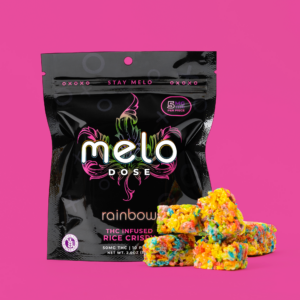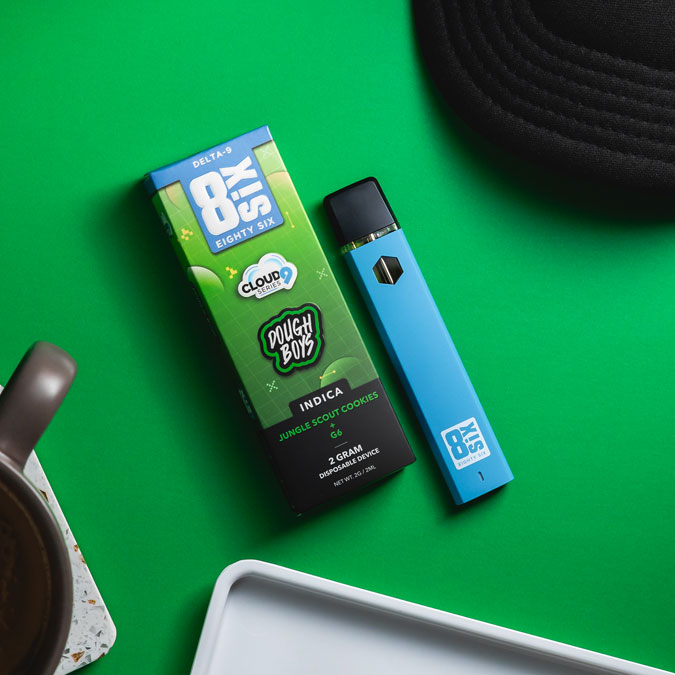Edibles and inhalables are the most popular ways to consume both cannabis and psychoactive hemp products. They’re easy, discreet, and don’t leave behind that tell-tale reek that can happen with bud or dabs. Though they’re both popular, they’re more different than they are alike and its experiences differ greatly. Let’s compare edibles and inhalables to help you decide which might be right for you.
What are Edibles?
-
Product on sale
 Melo Dose – Rainbow 50MG Delta-9 THC Rice CrispyOriginal price was: $9.99.$4.99Current price is: $4.99.
Melo Dose – Rainbow 50MG Delta-9 THC Rice CrispyOriginal price was: $9.99.$4.99Current price is: $4.99. -
Product on sale
 Berry Burst 1000MG Delta-8 THC GummiesOriginal price was: $14.99 – $149.90.$14.99 – $119.99Current price is: $14.99 – $119.99.
Berry Burst 1000MG Delta-8 THC GummiesOriginal price was: $14.99 – $149.90.$14.99 – $119.99Current price is: $14.99 – $119.99.
Edibles are foods, candies, and beverages that have psychoactive cannabinoids, usually THC, but sometimes CBD, added to its recipes during production so that when they are eaten and digested by the body, they make us feel high. Occasionally, a person may take an edible and end up not feeling effects, even after several hours. This can be caused by many things from a high tolerance to having eaten too much or not enough before or after dosing an edible. If this happens to you, don’t immediately up your dosage until you’ve tried the same dosage at least one more time to make sure it wasn’t a fluke or a bad batch of edibles.
While edibles can be hit or miss sometimes, the big draw of them is that they are much less harmful to your body than inhalables would, which can weak havoc on your respiratory system.
What are Inhalables?
Inhalables are cannabis products that are made to be inhaled, like dabs, joints, vape cartridges, and disposable vape pens. Besides joints, these products contain refined cannabinoids by-products such as distillate, live resin, or live rosin.
Inhalables are typically sold as prefilled disposables devices, in cartridges that screw onto a rechargeable battery or raw by the gram for dabbing. These types of inhalables are less harmful than smoking joints or blunts because your lungs aren’t exposed to smoke, tobacco, or ash; though they can also irritate your throat and lungs, especially if you’re already sick.
The effects created by inhalables are most similar to those of a joint, especially if you choose a Full Spectrum cart or disposable. Distillate can create strong effects, but because so much of the whole plant profile has been reclaimed during processing, the high from distillate can sometimes feel a bit flat. For this reason, many people prefer other varieties such as live rosin or live resin.
Difference #1: How They’re Processed In Our Body
We already mentioned how cannabis inhalables enter our body through the respiratory system. This is a very quick route to the bloodstream, so we feel the effects almost immediately of inhaling. Edibles, on the other hand, enter our body through the digestive system, which is a much-slower pathway compared to the former, involving many more organs and taking much longer for the effects to be felt, sometimes up to two hours after eating.
Difference #2: Experience & Effects
Compared with respiration, digestion is a complex process that is unique to each person; and several factors can affect digestion and how cannabinoids are broken down by our bodies.
Factors such as weight, metabolism, and genetics all play a role in how our digestion system works, also affecting how much of the psychoactive cannabinoid(s) our body is able to absorb.

Because of this, it’s much harder to predict how edibles affect us, especially in comparison to inhalables, which generally creates the same effects each time. When edibles do finally kick in, after as much as two hours after at times, it is a powerful, full-body experience lasting for several hours. Edibles create effects immediately and they can also be quite strong, but short-lived, peaking and trailing off after 2-3 hours.
Difference #3: Tolerance
Tolerance refers to how much cannabis it takes for you to feel its effects. People with a lower tolerance don’t need much to get lifted, while those with a higher tolerance require significantly more to feel the same effect. The relationship between tolerance and inhalables is more straightforward, whereas the relationship between edibles and tolerance is different. Occasionally, some people experience something called first-time tolerance with edibles, where they eat a dosage and do not feel its effects, even after several hours.
There are a lot off factors that can affect this, including weight, metabolism, and genetics, so it can be harder to make generalizations or guesses about how strong of an edible you might need. With inhalables, because the effects are felt so quickly, it’s easier to get a sense of what your tolerance is, so you know when to stop.
Difference #4: Varieties & Budget

When it comes to variety, there are thousands of options available for both edibles and inhalables. The one factor that gives edibles the leg up is its wide variety of products.
Inhalables come in a plethora of strains, blends, and flavors; but edibles, with their options to be in sodas, teas, candy, chips, cookies, and pastries, definitely have the choice advantage.
Edibles also tend to be a bit more budget-friendly than inhalables – to the tune of $2.50 for an individual piece of candy, while you’d be lucky to find a full gram of vape cartridge for an upwards of $15-20.
Closing Thoughts
Like with most things to do with cannabis and hemp, it all comes down to personal preference and the experience you are looking to have. And whether you choose to opt for edibles or inhalables, Eighty Six has you covered with premium, potent products, no matter the vibe you’re looking to explore!







